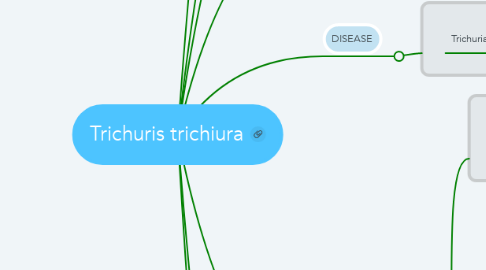
1. Morphology
1.1. Egg
1.1.1. 50-54 x 20-23 µm barrel shaped bipolar, mucoid plugs at the ends 3 layer shell, bile stained unembryonated when passed egg may be distorted following therapy.
1.2. Adult Male
1.2.1. smaller than the female tail (posterior end) is greatly curved posterior end has one spicule protected by a spined retractile sheath
1.3. Adult Female
1.3.1. 4-5 cm x 0.5 mm anterior end is thread like blunt, rounded, posterior end
2. TRANSMISSION
2.1. Feco-oral transmission
3. HABITAT
3.1. Large intestine
4. LIFE CYCLE
4.1. Infective stage: fully embyronated eggs
4.2. Diagnostic stage: characteristic barrel shaped eggs
5. DISEASE
5.1. Trichuriasis
6. CLINICAL PICTURE
6.1. Light T. trichiura infection usually is asymptomatic
6.2. Heavy T. trichiura infection is characterized by:
6.2.1. Abdominal pain and distension
6.2.2. Bloody or mucoid diarrhea, tenesmus, weight loss and weakness
6.2.3. Prolapse of the rectum is occasionally seen especially in children
6.2.4. Mild to moderate anemia
6.3. IMMUNE RESPONSE
6.3.1. Increased serum IgE could be noticed in heavy infection. Cell mediated immune response is entitled mainly during trichuriasis.
7. DIAGNOSTIC PROCEDURES
7.1. Laboratory
7.1.1. Stool analysis with zinc sulphate concentration method is an ideal way for detection of the characteristic eggs of T. trichiura
7.1.2. Kato thick smear is used for determination of the intensity of infection and monitor the therapy.
